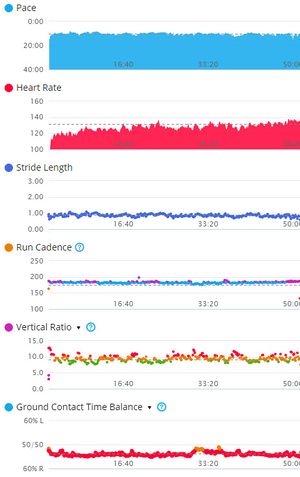Running Dynamics

Many newer Garmin watches combined with a special chest strap (HRM-Run) will provide extra metrics that can give insight into your Running Form. The Garmin watches will provide these metrics in real time, allowing you to see the effect of changes in your form, similar to other Running Sensors. These metrics include:
- Cadence. My Comparison of Cadence Monitors showed that the Garmin HRM-Run provides an accurate measurement of your Cadence. This is probably the single most important metric in running, and this approach is more accurate than using the accelerometer built into a watch itself.
- Vertical Oscillation. This is how much the torso moves up and down with each stride. It is generally believed that less Vertical Oscillation is a better, but I suspect that this is an oversimplification. Some are part of a runners vertical movement is likely to be elastic in nature (consider a bouncing rubber ball), some of the vertical motion will be while the runner is airborne (ballistic), and some of the vertical motion is the deceleration as the runner lands. So it seems likely to me that excessive vertical oscillation is bad, but it's a tricky to know what excessive is likely to be, or how to correct it.
- Ground Contact Time (GCT). The Science of Running Economy generally shows that longer Ground Contact Time is correlated with poorer Running Economy. I wish that Garmin would calculate and display Ground Contact Time as a percentage of overall stride time, as I suspect this would be a much more useful metric. However, if you're Cadence is fairly constant this is less of an issue.
- Ground Contact Time Balance. This is the relative Ground Contact Time ratio of the left and right feet, which will reveal potential imbalances in the body. Next to cadence, this might be one of the most valuable metrics, as it gives insight into an imbalance that seems unlikely to trigger injuries.
- Stride Length. This is computed from your Cadence and your running pace, and its value seems dubious at best. It's far better to focus on your cadence.
- Vertical Ratio. This is Vertical Oscillation to Stride Length ratio, and it's unclear what the value of this metric would be.
1 Watches
Garmin supports Running Dynamics in their 620, 920XT, Epix, Fenix 3 and a number of other watches. The metrics are displayed in real time on the watch, as well as being uploaded to the Garmin Connect website for later analysis.
2 The HRM-Run
To get the Running Dynamics you have to have a compatible chest strap, the HRM-Run. The latest version of the HRM-Run is the "HRM4", which has a different form factor to the earlier versions. The latest form factor is quite a bit smaller, and more rounded, so it's far less likely to chafe on long runs. The biggest downside to this style is that you can't unplug the transmitter from the strap, which may reduce its longevity. You can also get the HRM-Tri, which gives you both Running Dynamics, and the ability to record your heart rate while swimming. So far, I've been extremely pleased with the update, and the reduction in chafing, so I'd recommend considering this is an upgrade.
